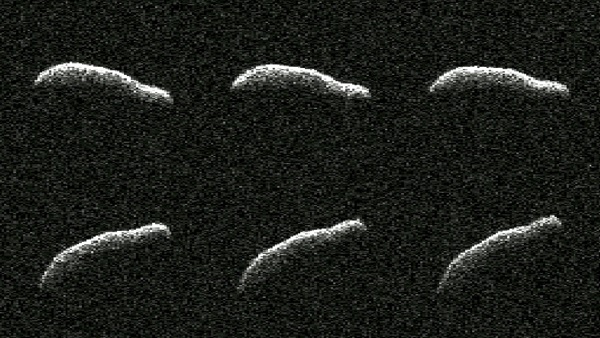Key Takeaways:
- Planetary radar observations of asteroid 2011 AG5, conducted between January 29 and February 4, 2024, revealed it to be highly elongated, approximately 1,600 feet long and 500 feet wide, making it one of the most elongated asteroids imaged by planetary radar.
- The observations, using the Goldstone Solar System Radar, also identified a concave dent on one hemisphere and small surface features, along with a rotational period of approximately 9 hours. The asteroid's surface is described as dark, comparable to charcoal.
- These detailed observations are crucial for understanding the physical characteristics of near-Earth objects (NEOs), aiding in the precise calculation of their orbital paths and the assessment of potential impact risks by organizations like NASA's Center for Near Earth Object Studies (CNEOS).
- While 2011 AG5's recent close approach posed no threat, the data gathered will further refine its future trajectory predictions, with its next relatively close approach anticipated in 2040.
A close approach of an asteroid roughly the size and shape of the Empire State Building gave astronomers the perfect opportunity to image the space rock in detail using planetary radar.
On Feb. 3, the asteroid, called 2011 AG5, came withing about 1.1 million miles (1.8 million kilometers) of Earth, or about five times the distance between Earth and the Moon. Using the 230-foot (70 m) Goldstone Solar System Radar dish in Barstow California, scientists at NASA’s Jet Propulsion Laboratory (JPL) closely tracked the asteroid, which is about 1,600 feet (500 m) long and some 500 feet (150 m) wide. The series of observations took place between Jan. 29 and Feb. 4.
“Of the 1,040 near-Earth objects observed by planetary radar to date, this is one of the most elongated we’ve seen,” said Lance Benner of JPL, who led the observations, in a NASA release.
The Goldstone observations also revealed a concave dent in one of the asteroid’s hemispheres, as well as indications of small surface features just several feet in diameter. The asteroid rotates roughly once every 9 hours, and if viewed with the human eye up close, it’s surface would appear as dark as charcoal.
Why the details of an asteroid matter
Radar observations like these are important for understanding more about the sizes, rotations, surfaces, and shapes of asteroids that we share our cosmic neighborhood with. They are also invaluable to scientists that track and study near-Earth objects (NEOs).
One such group is NASA’s Center for Near Earth Object Studies (CNEOS), which is tasked with precisely calculating the orbital paths of all known asteroids to assess any possible threats to Earth.
To do this, CNEOS researchers require detailed information on the asteroid’s motion. But they also need to know about the asteroid’s rotation, reflectivity, and shape, as these attributes can play a role in how sunlight striking the asteroid’s surface might nudge it into a slightly different orbital path. Without detailed characterization, scientists can’t make an accurate assessment of an asteroid’s true threat to Earth.
Scientists had already calculated that this close approach of 2011 AG5 posed no risk to our planet. But upon the asteroid’s initial discovery in 2011, they did have to carefully make sure.
“Interestingly, shortly after its discovery, 2011 AG5 became a poster-child asteroid when our analysis showed it had a small chance of a future impact,” said Paul Chodas, the director for CNEOS. “Continued observations of this object ruled out any chance of impact, and these new ranging measurements by the planetary radar team will further refine exactly where it will be far into the future.”
Scientists calculated that asteroid 2011 AG5 orbits the Sun once every 621 days. But it won’t make an exceptionally close pass by Earth until 2040, when it will come within about 670,000 miles (1.1 km) of our planet. And don’t worry, it’s won’t pose a threat then either.










